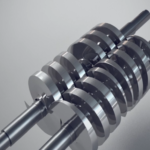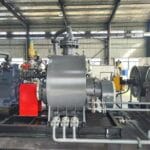Slug flow, a distinct gas – liquid two – phase flow pattern, features liquid in large slugs separated by gas, with an alternating gas – liquid flow. In oilfield operations, understanding slug flow is crucial.
I. Causes of Slug Flow
- Gas – Liquid Velocity Difference:Gas often flows faster. It can push liquid into large slugs, triggering slug flow.
- Pipeline Geometric Factors:Bends, diameter changes, and inclination in pipelines affect gas – liquid flow, causing slug flow.
- Gas – Liquid Ratio:When the ratio is in a certain range, slug flow is likely.
- Fluid Physical Properties:Liquid’s viscosity, surface tension, and gas’s density, viscosity affect the gas – liquid interface, potentially leading to slug flow.
- Flow Interference:Obstacles in pipelines or valve throttling can change flow, inducing slug flow.
II. Types of Oil Wells Prone to Slug Flow in Oilfields
- High Gas – Liquid Ratio Oil Wells:These wells have a high gas – liquid ratio. Fast – flowing gas can form slug flow while pushing liquid. For example, in late – stage oil wells, more gas escapes, increasing the ratio and causing frequent slug flow.
- Oil Wells in Complex Terrain Areas:In mountainous or offshore areas, pipelines may have many bends, undulations, or diameter changes. Gas – liquid flow through these structures promotes slug flow. Offshore subsea pipelines are a good example.
- Low – Permeability Reservoir Oil Wells:Low – permeability reservoirs cause poor fluid flow. Gas – liquid flow interference in these wells can lead to slug flow, affecting production.
III. Performance of Different Pumps under Slug Flow Conditions
Different pumps perform differently under slug flow. Twin – screw multiphase pumps have unique advantages.
Performance Advantages of Twin – Screw Multiphase Pumps in Slug Flow
- Excellent Gas – Liquid Mixing Handling Capacity:The screws and bushings form sealed chambers. These can handle gas – liquid mixtures well. Even with a changing gas – liquid ratio in slug flow, they maintain continuous transportation. Gear and vane pumps struggle with gas – liquid mixing and may block.
- Minimal Pressure Pulsation:Slug flow makes pressure unstable. Twin – screw multiphase pumps have little pressure pulsation. This protects pipelines and equipment. Diaphragm pumps, however, have large pulsations.
- High Operational Stability:Twin – screw multiphase pumps have a simple design with few moving parts. They stay stable in slug flow, rarely shutting down due to component failure. Complex – structured pumps like some piston pumps are more likely to malfunction.
- Good Medium Inclusiveness:Oilfield fluids may have impurities. Twin – screw multiphase pumps can handle impure media well, without getting stuck. Precision – structured pumps like metering pumps may be affected.
- Low Maintenance Cost:Twin – screw multiphase pumps wear less in slug flow. Their long – term stability means a longer maintenance cycle and lower cost. Gear and vane pumps wear more, increasing maintenance and downtime.
In oilfield production, twin – screw multiphase pumps help deal with slug flow, ensuring continuous production and reducing costs.





1 Comment
小狮
good idea